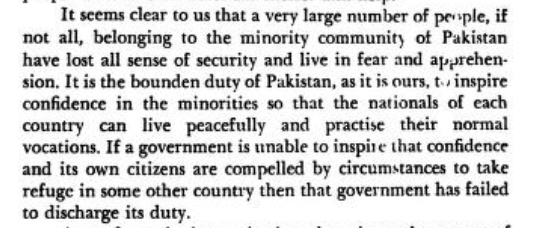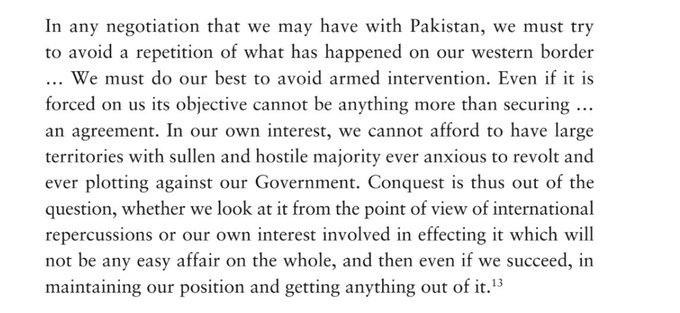While any discussion of Partition tends to focus a lot on the migrations and violence circa 1947, we tend to forget the mayhem that followed in Bengal with a lag. As late as 1950! In Bengal the violence peaked in late 1949 – 1950 unlike in Punjab. Particularly in East Pakistan.
The discussion of these riots and the agreements that ensued in 1950 in TCA Raghavan’s book “The People Next Door” make an interesting read.
The partition in 1947 had left both sides of Bengal with similar proportions of minority populations. West Bengal had five million Muslims in a population of twenty one million. East Pakistan was left with eleven million Hindus in a population of thirty nine million.
Unlike in the Punjab, a full-fledged ethnic cleansing did not occur in Bengal. Perhaps in part because of the presence of Gandhi in Bengal for a couple of crucial months in 1947. There could be other reasons that can explain why Bengal didn’t start with a blank slate unlike Punjab. I can only think of the Gandhi-factor as of now
The violence festered in Bengal right up to 1950, but it peaked in the month of February that year, particularly in East Pakistan. The violence against Hindus provoked much political unrest in India, causing Nehru to assume stances that seem very hawkish to us today.
Jawaharlal Nehru addressed the Parliament on Feb 23rd of 1950, expressing outrage at the East Pakistan riots
Then he went on to suggest a possible military action against East Pakistan while concluding his speech – Note the words – “We shall have to adopt other methods”
But then the invasion idea was dropped. It was not just a question of Nehru being pusillanimous. The President of India, Rajendra Prasad, a supposed right winger, wrote a letter to Nehru, suggesting that he drop the idea of attacking / annexing East Pakistan!
I find this curious.
An interesting example of a “conservative” voice in India (Rajendra Prasad) persuading the supposedly more dovish and liberal Nehru to drop the idea of military action against East Pakistan
Another thing that I find curious about this episode is that the very large scale migrations that ensued in early 1950, were mostly undone by the end of the year by reverse migrations, following the Nehru-Liaquat agreement in April 1950.
Between February 7th and April 8th 1950, 1.5 million people crossed the borders! 850K Hindus from East Pakistan to West Bengal, and 650K Muslims from West Bengal to East Pakistan.
The agreement was signed on 8th April 1950, but it did not reverse the migration tide immediately. Between 9th April and 25th July, 1.2 million more Hindus left East Pakistan for India, while only 600K returned back to Pakistan prompted by the agreement. That’s roughly a return-ratio of 1 in 2.
But it appears the ratio was much better for Muslims for exactly the same period (9th April to 25th July) following the treaty. In this timeframe, 450K Muslims left West Bengal for East Pakistan, but 300K returned back. That’s a ratio of 2 in 3.
So it appears the agreement reassured the Muslims more than it did the Hindus. But nevertheless it did prompt Hindus to return back to East Pakistan in larger numbers by the end of the year. A million Hindus had returned back to East Pakistan by December of that year.
One wonders if we could’ve had a more peaceful subcontinent in later decades, had the powers that be sat down and planned a more systematic population transfer, instead of idealistic reassurances to minorities, which did help stall the large scale transfer in the short run, but kept communal tensions simmering for several more decades.
References:
- TCA Raghavan’s “The People Next Door”
- Jawaharlal Nehru’s Speeches, Vol II
The author tweets @shrikanth_krish



“An interesting example of a “conservative” voice in India (Rajendra Prasad) persuading the supposedly more dovish and liberal Nehru to drop the idea of military action against East Pakistan”
Brings out great nuance
Read R.C.Majumdar’s book on history of India’s freedom struggle vol 3 published in 1963. It attacks Nehru for pussilanimity in providing security and help to Hindus from East Pakistan. R. C. Majumdarnhimselgvwas from Banga, what is now called as Bangladesh.
Rajendra Prasad was not a right winger but a “trad” . Also Rajendra Prasad and all were like Chindambaram of there times, no political power (hence president) lot of “trad” power to give Congress “Hindu legitimacy”
And this incident clearly illustrates the folly of fighting other Hindu ethnicities/communities battles. There is a reason why Bengal partition is talked more outside Bengal and within non Bengalis right wing, than Hindu Bengalis. There is a lesson for all of us
It has changed significantly recently.
Thanks to the failure to do a complete population transfer on the eastern border , ( as was done on the western border ) ; India has suffered in 4 ways ; 1) One way flow of Hindus with no reciprocity ; 2) Increased Muslim population in Assam, West Bengal, due to porous border with Bangladesh ; 3) Several border districts in Assam, West Bengal are now Muslim majority and life is as hellish for Indian Hindus in these districts as inside Bangladesh ; 4) Inevitable Muslim separatist movement , due to changed demographics
No group in the world is as incompetent as Hindus in dealing with other religions.
where are the zoroastrians?
where are the greco-roman pagans?
where are the nestorians?
how many jews are there?
Exactly, compared to other pagans, Hinduism success has been better than average.
I keep hearing that life is hell for Hindus in majority Muslim districts in India. Is there any proof, though? It’s plausible considering how minorities are treated in most Muslim countries, but I’d like to see/hear at least one account from a Hindu living under local Muslim terror within Assam or W. Bengal.
Someone from such a district would be an interesting guest on the Browncast.
Hindu Samhati was started by late Tapan Ghosh in West Bengal ; Harassment of Hindus is going on all over West Bengal, not just districts where Muslims are majority, but also where Muslims are a sizeable minority
http://hindusamhati.net/news
lists dozens of low level harassment and riots and abductions of Hindu girls by Muslims in West Bengal